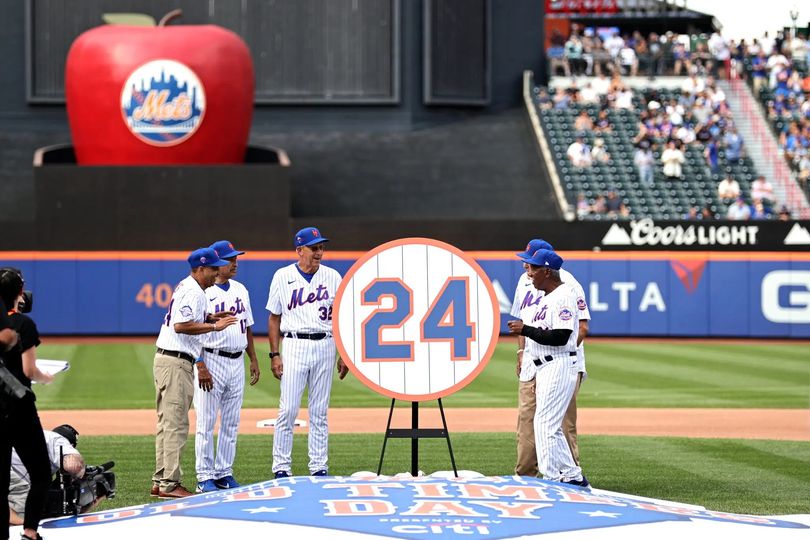
The Mets did more than retire a famous baseball number Saturday afternoon, stunning a nostalgia-nourished crowd at Citi Field when it was revealed that Willie Mays’ No. 24 would formally be retired. The team honored its recent vow to recognize its rich franchise history on the day it celebrated the return of Old Timers’ Day. And did so note-perfectly.
Yes, 24 was Willie Mays’ number, and no athlete in American sports history is more closely identified with that digit than the “Say Hey Kid.” But it was also an essential piece of the heart of a woman named Joan Whitney Payson, a New York Giants fan to her core and a member of the team’s board, the lone “no” vote when the time came to decide on whether the team should move to San Francisco.
A few years later, Payson became the Mets’ charter owner, a fixture in her field box, the first woman to ever own a ballclub. And though she lived and died with her Mets, Willie Mays remained her favorite. It was her dream that Willie finish his career in New York. And in May 1972, when it became clear the Giants would make Mays available, she pounced.
Mays himself, comfortable in San Francisco, was unsure about moving East, knowing he was no longer the breathtaking force of nature who’d once roamed center field at Coogan’s Bluff. But Joan Payson made him a promise.
“Willie,” she said, according to team lore, “you’ll be the last Met to ever wear No. 24.”
That was good enough for him. Famously, he hit a home run in his very first game as a Met — against the Giants, of all teams, on May 14, 1972. He was 41 by then, no longer a kid, but it didn’t matter. Mets fans were delighted to have him back home. He hit the final 14 of his 660 lifetime homers as a Met.
But Payson died not long after Mays retired in 1973. Twenty-four disappeared for a while, but Payson’s wish was never granted. Someone named Kelvin Torve was somehow issued the number in 1990. The backlash was immediate, and Torve was soon wearing 39. Rickey Henderson and Robinson Cano were given special dispensations when they became Mets.
The number was in repose, but not retired. Not until Saturday.
History has often been cruel to Mays’ final days as a Met. Any aging ballplayer, any sport, the simile is always the same: Willie-Mays-falling-down-in-the-outfield. It is also a grossly unfair stigma. Yes, Mays lost a ball in the sun in Game 2 of the 1973 World Series. But so did Oakland’s Joe Rudi (who was 27) and Reggie Jackson (also 27).
The Mets were only in the World Series because Mays drove in a key run in decisive Game 5 of the NLCS. And in that wild Game 2 in Oakland? Mays’ two-out single in the 12th inning broke a 6-6 tie in a game the Mets would win 10-7.
But 24, in truth, isn’t being taken out of circulation for Mays’ 491 plate appearances with the Mets. It will hang forever next to 14, 17, 31, 36, 37, 41 and 42 because of what he meant to baseball New York, especially when he was young and he’d play stickball with the neighborhood kids in Harlem in his civvies after grinding nine innings in his uniform. It’s why Joan Whitney Payson fell in baseball love with him. And she wasn’t alone.
It will honor the .312/.387/.593 slash line he had a New York Giant; toast the .345/41 HR/110 RBIs he accumulated when he won his first MVP, at 23, in 1954; exalt the greatest defensive play of them all, the one he made that fall, in the World Series against Cleveland, running down Vic Wertz’s fly ball in the deepest pocket of the Polo Grounds.
Mostly, it will be a permanent reminder that the Mets were, indeed, descended from two baseball fathers. Past ownership was unabashed about the team’s ties to the Dodgers, but the Mets’ colors are orange in addition to blue. Perhaps Mays’ best days came in a uniform other than the Mets, but so did Jackie Robinson’s. And now 24 and 42 will be tied to New York’s National League team forever. As they should be.
Forty-nine years ago next month, a tired Mays walked to a microphone at old Shea Stadium and told a weepy crowd, “Willie, say goodbye to America.” But a part of New York’s baseball soul never truly said goodbye to him. And now it never will. -Mike Puma
